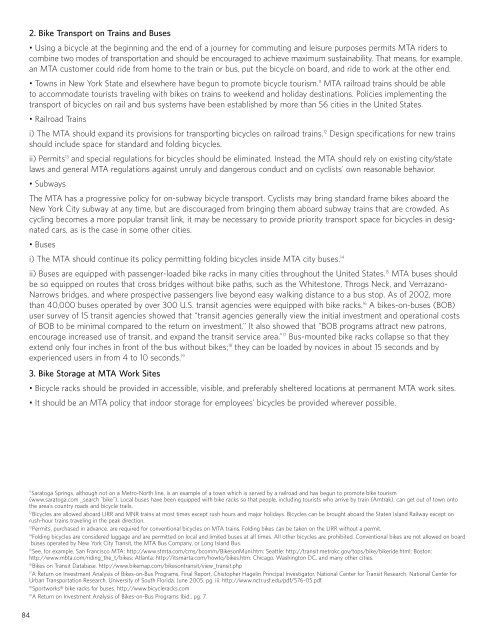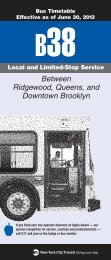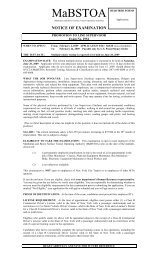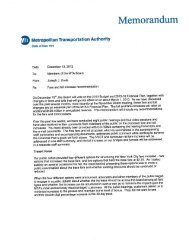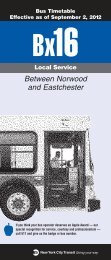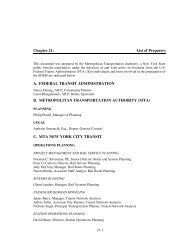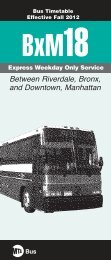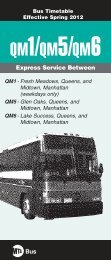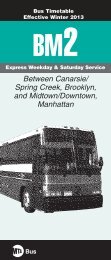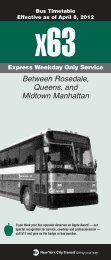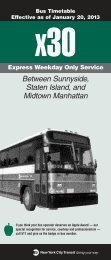Greening Mass Transit & Metro Regions: The Final Report - MTA
Greening Mass Transit & Metro Regions: The Final Report - MTA
Greening Mass Transit & Metro Regions: The Final Report - MTA
Create successful ePaper yourself
Turn your PDF publications into a flip-book with our unique Google optimized e-Paper software.
84<br />
2. Bike Transport on Trains and Buses<br />
• Using a bicycle at the beginning and the end of a journey for commuting and leisure purposes permits <strong>MTA</strong> riders to<br />
combine two modes of transportation and should be encouraged to achieve maximum sustainability. That means, for example,<br />
an <strong>MTA</strong> customer could ride from home to the train or bus, put the bicycle on board, and ride to work at the other end.<br />
• Towns in New York State and elsewhere have begun to promote bicycle tourism. 11 <strong>MTA</strong> railroad trains should be able<br />
to accommodate tourists traveling with bikes on trains to weekend and holiday destinations. Policies implementing the<br />
transport of bicycles on rail and bus systems have been established by more than 56 cities in the United States.<br />
• Railroad Trains<br />
i) <strong>The</strong> <strong>MTA</strong> should expand its provisions for transporting bicycles on railroad trains. 12 Design specifications for new trains<br />
should include space for standard and folding bicycles.<br />
ii) Permits13 and special regulations for bicycles should be eliminated. Instead, the <strong>MTA</strong> should rely on existing city/state<br />
laws and general <strong>MTA</strong> regulations against unruly and dangerous conduct and on cyclists’ own reasonable behavior.<br />
• Subways<br />
<strong>The</strong> <strong>MTA</strong> has a progressive policy for on-subway bicycle transport. Cyclists may bring standard frame bikes aboard the<br />
New York City subway at any time, but are discouraged from bringing them aboard subway trains that are crowded. As<br />
cycling becomes a more popular transit link, it may be necessary to provide priority transport space for bicycles in designated<br />
cars, as is the case in some other cities.<br />
• Buses<br />
i) <strong>The</strong> <strong>MTA</strong> should continue its policy permitting folding bicycles inside <strong>MTA</strong> city buses. 14<br />
ii) Buses are equipped with passenger-loaded bike racks in many cities throughout the United States. 15 <strong>MTA</strong> buses should<br />
be so equipped on routes that cross bridges without bike paths, such as the Whitestone, Throgs Neck, and Verrazano-<br />
Narrows bridges, and where prospective passengers live beyond easy walking distance to a bus stop. As of 2002, more<br />
than 40,000 buses operated by over 300 U.S. transit agencies were equipped with bike racks. 16 A bikes-on-buses (BOB)<br />
user survey of 15 transit agencies showed that “transit agencies generally view the initial investment and operational costs<br />
of BOB to be minimal compared to the return on investment.” It also showed that “BOB programs attract new patrons,<br />
encourage increased use of transit, and expand the transit service area.” 17 Bus-mounted bike racks collapse so that they<br />
extend only four inches in front of the bus without bikes; 18 they can be loaded by novices in about 15 seconds and by<br />
experienced users in from 4 to 10 seconds. 19<br />
3. Bike Storage at <strong>MTA</strong> Work Sites<br />
• Bicycle racks should be provided in accessible, visible, and preferably sheltered locations at permanent <strong>MTA</strong> work sites.<br />
• It should be an <strong>MTA</strong> policy that indoor storage for employees’ bicycles be provided wherever possible.<br />
11Saratoga Springs, although not on a <strong>Metro</strong>-North line, is an example of a town which is served by a railroad and has begun to promote bike tourism<br />
(www.saratoga.com _search "bike"). Local buses have been equipped with bike racks so that people, including tourists who arrive by train (Amtrak), can get out of town onto<br />
the area’s country roads and bicycle trails.<br />
12Bicycles are allowed aboard LIRR and MNR trains at most times except rush hours and major holidays. Bicycles can be brought aboard the Staten Island Railway except on<br />
rush-hour trains traveling in the peak direction.<br />
13Permits, purchased in advance, are required for conventional bicycles on <strong>MTA</strong> trains. Folding bikes can be taken on the LIRR without a permit.<br />
14Folding bicycles are considered luggage and are permitted on local and limited buses at all times. All other bicycles are prohibited. Conventional bikes are not allowed on board<br />
buses operated by New York City <strong>Transit</strong>, the <strong>MTA</strong> Bus Company, or Long Island Bus.<br />
15See, for example, San Francisco <strong>MTA</strong>: http://www.sfmta.com/cms/bcomm/BikesonMuni.htm; Seattle: http://transit.metrokc.gov/tops/bike/bikeride.html; Boston:<br />
http://www.mbta.com/riding_the_t/bikes; Atlanta: http://itsmarta.com/howto/bikes.htm; Chicago, Washington DC, and many other cities.<br />
16Bikes on <strong>Transit</strong> Database. http://www.bikemap.com/bikesontransit/view_transit.php<br />
17A Return on Investment Analysis of Bikes-on-Bus Programs, <strong>Final</strong> <strong>Report</strong>, Chistopher Hagelin Principal Investigator, National Center for <strong>Transit</strong> Research, National Center for<br />
Urban Transportation Research, University of South Florida, June 2005, pg. iii. http://www.nctr.usf.edu/pdf/576-05.pdf<br />
18Sportworks® bike racks for buses. http://www.bicycleracks.com<br />
19A Return on Investment Analysis of Bikes-on-Bus Programs Ibid., pg. 7.


